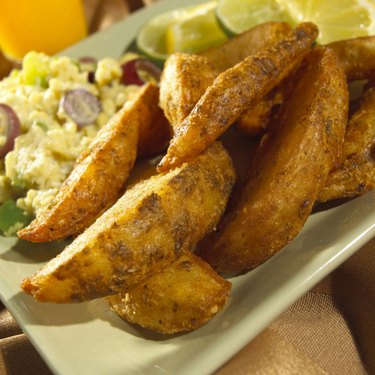
If you're craving the perfectly crisp french fry or a smooth, creamy potato salad, the first step is choosing the right potato. With so many varieties out there, varying in color, size and shape, it can be difficult to discern what potato is best suited for which dish. Russet and white potatoes are two of the most readily available potato varieties, but, despite some similarities in appearance, they have vastly different characteristics, which makes them each better suited for different potato dishes.
Shape, Skin and Flesh
Video of the Day
Russet potatoes tend to be larger and more oblong in shape than white potatoes. With their brown -- russet -- colored skin and beige-white flesh color, russets also have a tougher skin. While edible, the skin on russets is most commonly kept for rustic potato dishes, such as skin-on french fries.
Video of the Day
White potatoes, on the other hand, are smaller and oval shaped, with a smoother more delicate, yellow-white colored skin. The flesh of white potatoes is smooth and pure white. When cooked, russet potatoes have a dry, fluffy, floury texture and a mild, earthy taste. Cooked white potatoes have a gently creamy texture that is denser than that of russets and while mild tasting, is a little sweet.
Starch and Moisture Content
Russet potatoes are high starch potatoes, which are also known as floury potatoes. This means they have a low moisture content, and will turn mealy when cooked. Russet potatoes, like all starchy potatoes, do not hold their shape well after cooked, unless cooked whole with the skin on.
White potatoes are medium-starch potatoes, also known as all-purpose potatoes. As medium starch potatoes, white potatoes also have moderate moisture content, and while they can be used to make fluffy, starchy potato dishes, like mashed potatoes, they hold their shape better than russet potatoes do.
Cooking Russet Potatoes
Russet potatoes are well suited baking, frying, mashing and roasting, although they are not recommended for potato dishes where the potato needs to keep its shape, such as for hasselback potatoes or for potato gratin. Russets are ideal for making french fries, as they fry up to a crisp, golden brown, and they can also be used to make skin-on baked potatoes. They are perhaps best know for being a wonderful potato for mashing, producing fluffy, light mashed potatoes.
Cooking White Potatoes
White potatoes are best suited for frying, mashing, steaming and boiling, and for making potato salads. The denser flesh of white potatoes means that cut cooked pieces will not disintegrate when they are dressed. Because they contain a moderate amount of starch, white potatoes can also be used to make mashed potatoes, although they will produce a less fluffy mashed potato than russets. As their skins are more delicate, white potatoes do not need to be peeled before mashing or for making salads. As they hold their shape well when peeled and cooked, white potatoes work well for potato gratins and other sliced, baked potato dishes.